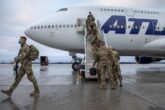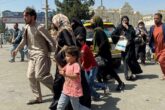March 16, 2009
A Pathway to Success in Afghanistan: The National Solidarity Program
In providing additional military forces for the Afghanistan war, the Obama administration has demonstrated that Afghanistan is no longer an economy-of-force campaign. But a troop surge alone is not enough to win the war. In orthodox counterinsurgency theory, providing essential services and strengthening governance are as important as fighting the enemy with guns and bullets.1 A precondition for allied success is an Afghan state that is legitimate in the eyes of its citizens and able to provide them with essential services. A renewed U.S. commitment to funding grassroots development and governance in Afghanistan must therefore accompany the influx of troops.
Watch a short video with CNAS Fellow Andrew Exum describing this policy brief:
The Afghan government’s National Solidarity Program (NSP) and other programs like it deserve much more American support. The president of the World Bank estimates the economic rate of return on the NSP to be almost 20 percent.2 NSP is exemplary not simply in terms of the tangible services it has delivered to Afghanistan’s population; “owned” by the Afghans and run with an emphasis on transparency, the NSP is one of the few initiatives from Kabul to have generated significant goodwill among rural communities. Furthermore, the NSP has achieved concrete successes at a price tag considerably lower than large-scale, Western-led initiatives.
Given the success of the NSP to date, the United States should not only continue its funding but should also help expand the program across Afghanistan. Only through steadfast support of the NSP and similarly structured enterprises can hard-won military gains be consolidated into an enduring, Afghan-led peace.
What is the NSP?
Upon assuming power in 2001, the post-Taliban government envisioned the creation of “national” development projects responsible for creating public trust in governance.3 These programs included a National Emergency Employment Program to provide jobs across the country, a National Health and Education Program to get basic health packages to citizens and get children back in school, a National Transportation Program to make Afghanistan a land bridge for South and Central Asia and the Gulf, a National Telecommunications Program to set up a cell phone network across the country and attract private investment, a National Accountability Program to build good financial management, and finally, a National Solidarity Program to carry out rural development, empower citizens in decision-making, and connect them to their government.
The NSP has become one of the government’s most successful rural development projects.4 Under the program, the Afghan Ministry of Rural Rehabilitation and Development (MRRD) disburses modest grants to village-level elected organizations called Community Development Councils (CDCs), which in turn identify local priorities and implement small-scale development projects.5 A limited number of domestic and international non-governmental organizations (NGOs) then assist the CDCs. Once a CDC agrees on a venture, $200 per family (with a ceiling of $60,000 per village) is distributed for project execution.6 Afghans contribute 10 percent of project costs through cash, labor, or other means.
Under this model, the NSP has built schools for thousands of children, constructed village water pumps that save many hours of labor, and assembled irrigation networks that have enabled far higher agricultural yields.7 More than 12,000 village development councils have been elected, more than 19,000 project plans have been approved, and nearly half of these projects have already been completed.8 The NSP is the only government program functioning in all 34 provinces, and it has affected nearly two-thirds of Afghanistan’s rural population.9 Moreover, women – whose inclusion is a mandatory component of the program – constitute 35% of the elected CDC representatives.10
The Limitations of Conventional, Western-led Development
Large scale Western-led development projects have accomplished much good in Afghanistan, and they have an important role to play in further reconstruction activities. But much of this conventional development assistance has done little to reinforce the legitimacy of the Afghan government.11 According to Oxfam, only one-third of all international aid is funneled through the Afghan government. The absence of an Afghan imprimatur on most sizable development projects means the central government often gets little credit when progress is made on the ground.
Worse still, traditional development programs have acquired a debilitating stigma in the eyes of many Afghans. A common Afghan complaint is that more funds are expended on the operation of international NGOs and their consultants than on Afghan needs. And even with the best of intentions, conventional assistance projects are often designed with an eye to donor constraints rather than recipient needs, often limiting the effectiveness of projects.12
The NSP: A Legitimate, Afghan-owned Alternative
In contrast to Western-led initiatives, the NSP is distinguished by the degree to which Afghans are personally invested in its projects. The high degree of Afghan participation stems from the way the program is structured: Afghan citizens are involved in every aspect of the decision-making process, from project selection to implementation, and the expenditure of funds is publicly tracked and monitored by villagers. Project results are tangible and of immediate use.
Moreover, the NSP also generates institutions at the local level that are crucial to any vision of a future, self-sustaining Afghan state. The elected Community Development Councils remain intact after project completion, and in some cases these structures have resolved protracted conflicts.13 The CDCs have also started to federate spontaneously, with dozens of villages pooling resources and completing larger scale projects that no one village could afford or manage alone. Building on this natural demand, the program has now facilitated the formation of District Development Assemblies, where the dozen or so CDCs in a district send representatives to a district level body to discuss, plan and organize larger projects. In this way, the NSP is helping villagers establish relationships as Afghan citizens that bridge traditional divides.
There is no better indicator of the NSP’s credibility at the grassroots level than the Taliban’s response to the program. Attuned to the widespread admiration for the NSP in rural communities across Afghanistan, the Taliban avoids attacking projects under its aegis.14 As Senator Carl Levin recently observed after a trip to a primary school built under the NSP, villagers from the three Afghan communities that had collaborated in its construction were “prepared to defend it with their lives against the Taliban.”15
None of this is to suggest that the NSP is some kind of panacea. Even a fully funded, optimally scaled program will not in and of itself ensure the emergence of a self-sustaining Afghan state. And there are other important development efforts in Afghanistan that must be supported in partnership with the government. Nonetheless, the NSP has to date proven to be one of the more successful methods of generating links between the government and Afghan citizens.
Supporting the NSP: The U.S. Role
Since its inception in 2003, NSP has received approximately $900 million from international donors.16 Although the United States provided $5.7 billion in assistance to Afghanistan in 2008, aid to the NSP still constitutes a tiny fraction of this overall budget: Congress appropriated a paltry $65 million in 2008.17
As the United States sends more forces to Afghanistan, the timely provision of funding for essential services and governance initiatives is critical. Supplemental funding for NSP should do two things:
First, the United States should provide funds to cover existing budget shortfalls. This will enable those “shovel-ready” projects currently languishing throughout Afghanistan to break ground. In areas where NSP initiatives have succeeded, follow-on projects should be initiated to take advantage of the momentum gained. Rural communities expect to move on from completed NSP projects to new initiatives under the program, and cutting their funding squanders carefully accumulated goodwill.
Second, the United States should help Afghanistan expand the NSP as quickly as possible. Such growth is consistent with the NSP’s original design, which incorporated the need for rapid scaling. Expansion over the next two years can begin by targeting the approximately 13,000 villages that currently lack coverage, including insecure areas in southern and eastern Afghanistan.18 In the long run, the United States can examine options that would help Afghanistan extend the NSP model into urban neighborhoods in need of effective governance.19 The United States could also provide funds at the district level to be managed by the District Development Assemblies, for larger infrastructure projects such as irrigation canals, roads and bridges.
MRRD estimates that NSP needs at least $300 million annually to continue existing operations and extend the program’s penetration into new areas.20 The United States should make use of as many budgetary avenues as possible, including boosting current USAID disbursements to ARTF, in order to help Afghanistan reach this goal.
Conclusion
Buttressing the Afghan government’s legitimacy — and the governance and development efforts that underpin it — is the fundamental coalition objective in Afghanistan today. The United States and its allies face a long and difficult road in Afghanistan. But by building relationships between Kabul and far-flung communities, the NSP is easing the journey ahead. Increasing support for programs like the NSP can strategically leverage all the instruments of American national power instead of relying on military force alone. And by partnering with Kabul, the United States can improve its own security by building an Afghan state through Afghan means.
Footnotes
- Department of the Army, FM 3-24 Counterinsurgency Field Manual (Headquarters, Department of the Army: Washington, DC, 2006).
- Robert Zoellick, “The Key to Rebuilding Afghanistan,” Washington Post (22 August 2008).
- Ashraf Ghani and Clare Lockhart, Fixing Failed States (New York: Oxford University Press, 2008), 205.
- Government of the Islamic Republic of Afghanistan, Ministry of Rural Rehabilitation and Development, “National Solidarity Programme,” http://www.nspafghanistan.org.
- World Bank, “Afghanistan’s National Solidarity Program: Overview & Challenges,” http://go.worldbank.org/FE0JQLDI10.
- Ibid.
- International Development Association, “Strengthening Local Governance and Promoting Community Based Development in Afghanistan,” (April 2007), http://go.worldbank.org/AE5ZOB5X90.
- Ghani and Lockhart, 205.
- World Bank.
- Mohammad Ehsan Zia, “Afghan Aid that Works,” Christian Science Monitor (16 May 2008).
- Matt Waldman, “Falling Short: Aid Effectiveness in Afghanistan,” Oxfam International (March 2008), http://www.oxfam.org/sites/www.oxfam.org/files/ACBAR_aid_effectiveness_paper_0803.pdf.
- Frankie Sturm, “Security through Development: Saving the National Solidarity Program in Afghanistan,” Truman National Security Project (28 October 2008), 1.
- Agency for Technical Cooperation and Development, “Transition Strategy and Cycle 2+ Communities: A Study of NSP, March-May 2007,” (July 2007), 45.
- Gregory Warner, “The Schools the Taliban won’t Torch,” Washington Monthly (December 2007); see also Sturm.
- Senator Carl Levin, “Opening Statement: Hearing on Afghanistan and Pakistan,” Senate Armed Services Committee (26 February 2009), http://levin.senate.gov/newsroom/release.cfm?id=308740.
- World Bank.
- Embassy of Afghanistan, News and Views, “Minister of Rural Rehabilitation and Development Completes Visit to U.S., Brazil,”
http://www.embassyofafghanistan.org/03.06.09zia.html. - Government of the Islamic Republic of Afghanistan, Ministry for Rural Rehabilitation and Development.
- Steven Ross and Seema Patel, “Breaking Point: Measuring Progress in Afghanistan” Center for Strategic and International Studies (2007), 73.
- Ministry for Rural Rehabilitation and Development.
More from CNAS
-
Afghanistan: Why Does Trump Want to Retake Bagram Air Base?
Lisa Curtis, senior fellow and program director at the Center for a New American Security joined Deutsche Welle to discuss President Trump's comments on the U.S. regaining con...
By Lisa Curtis
-
A Failure to Plan: Examining the Biden Administration’s Preparation for the Afghanistan Withdrawal
Afghanistan, Iraq, and Vietnam. One failure is a horrible accident; two failures are a tragic coincidence; three failures are a disturbing trend that shows the U.S. government...
By Christopher D. Kolenda
-
Against All Odds
Eighteen months after taking power, the Taliban is intensifying its repression of Afghan civil society and cracking down on the rights and freedoms of all Afghans, especially ...
By Lisa Curtis, Annie Pforzheimer & Jan Mohammad Jahid
-
To Help Afghanistan, Engage Its Political Opposition
The effort to help Afghans shape a better alternative should begin now....
By Richard Fontaine & Lisa Curtis





